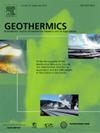土壤分层与地下水平流耦合作用对垂直钻孔换热器热性能的影响评价
IF 3.9
2区 工程技术
Q3 ENERGY & FUELS
引用次数: 0
摘要
地热能作为一种低碳替代能源的兴趣日益增长,这强调了对地下环境进行精确热表征的必要性。为了提高复杂地质条件下地源热泵系统的设计精度和运行可靠性,本研究建立了同时考虑土壤分层和地下水平流的改进模型来评价井下换热器的热性能。在ANSYS软件中建立了多层土壤夏季模式下的耦合传热三维数值模型,并与现场热响应试验数据进行了验证,误差小于5%。结果表明,忽略土壤分层会导致热影响距离偏差高达18.6%,换热效率偏差高达8.4%,有可能低估钻孔间距和系统性能。此外,在第3层土壤中加入地下水平流增强了对流热输运,使出水温度降低0.6°C,换热效率提高40.96%,而地下水平流影响率最大达到10.97%。这些发现表明,分层和平流都会影响土壤的温度分布和热性能,为优化非均匀含水层环境中的井眼设计、井距和地源热泵的长期运行提供了重要的见解。这项工作为优化复杂地质条件下的地源热泵系统提供了重要见解,在实际应用中实现了更准确的热交换预测和高效的多井布局。本文章由计算机程序翻译,如有差异,请以英文原文为准。
Thermal performance assessment of coupled soil stratification and groundwater advection effects on vertical borehole heat exchanger
The growing interest in geothermal energy as a low-carbon alternative underscores the need for precise thermal characterization of subsurface environments. To enhance the design accuracy and operational reliability of ground source heat pump systems under complex geological conditions, this study builds an improved model that simultaneously accounts for soil stratification and groundwater advection to evaluate the thermal performance of borehole heat exchangers. A three-dimensional numerical model was established in ANSYS to simulate coupled heat transfer within multi-layered soil under summer-mode operation and was validated against in-situ thermal response test data, demonstrating errors below 5 %. Results indicate that neglecting soil stratification can lead to deviations of up to 18.6 % in thermal influence distance and 8.4 % in heat transfer efficiency, potentially risking underestimation of borehole spacing and system performance. Moreover, incorporating groundwater advection in the 3rd soil layer enhances convective heat transport, lowering outlet water temperatures by 0.6 °C and improving heat transfer efficiency by 40.96 %, while the proposed groundwater advection influence rate reached a maximum of 10.97 %. These findings demonstrate that both stratification and advection affect temperature distribution and thermal performance of soil, offering crucial insights for optimizing borehole design, spacing, and long-term GSHP operations in heterogeneous aquifer environments. This work provides critical insights for optimizing ground source heat pump systems under complex geological conditions, enabling more accurate heat exchange predictions and efficient multi-borehole layouts in practical applications.
求助全文
通过发布文献求助,成功后即可免费获取论文全文。
去求助
来源期刊

Geothermics
工程技术-地球科学综合
CiteScore
7.70
自引率
15.40%
发文量
237
审稿时长
4.5 months
期刊介绍:
Geothermics is an international journal devoted to the research and development of geothermal energy. The International Board of Editors of Geothermics, which comprises specialists in the various aspects of geothermal resources, exploration and development, guarantees the balanced, comprehensive view of scientific and technological developments in this promising energy field.
It promulgates the state of the art and science of geothermal energy, its exploration and exploitation through a regular exchange of information from all parts of the world. The journal publishes articles dealing with the theory, exploration techniques and all aspects of the utilization of geothermal resources. Geothermics serves as the scientific house, or exchange medium, through which the growing community of geothermal specialists can provide and receive information.
 求助内容:
求助内容: 应助结果提醒方式:
应助结果提醒方式:


